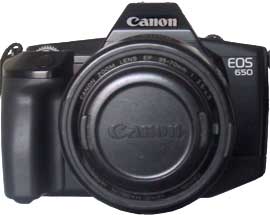
Lens Mount: EF (autofocus)
Film type: 35mm
Approx. dates of manufacture: 1987-1989
Battery: one 6V 2CR5 lithium
Approx. original price: $325
Approx. street value: Low
Purchased for $6 at a thrift shop—body only. How the mighty have fallen.
This was one of the few Canon cameras which was revolutionary among their lines. Most of their cameras are evolutionary—they build on something prior even if they add new features. But to understand this camera, you pretty-much have to go all the way back to the early 1960s and the original Canonflex.
For 35mm SLRs, the holy grail in the 1980s was autofocus. Canon had experimented with it on their AL-1, which had a thing called "focus confirmation," whereby it told you when it thought the image was in focus. It wasn't much account.
.jpg) Then around 1985, they came up with their version of true autofocus (where the camera controls the lens) on their T80. The problem was that a) wasn't very good and b) the Minolta Maxxum line was excellent. The T80 was dead on arrival.
Then around 1985, they came up with their version of true autofocus (where the camera controls the lens) on their T80. The problem was that a) wasn't very good and b) the Minolta Maxxum line was excellent. The T80 was dead on arrival.
The problem was that all of the major makers had huge customer bases with a significant investment in lenses using proprietary mounts: in Canon's case the FD mount. In 1987 the FD mount was about 20 years old—that's a lot of lenses. They hated and feared the idea of changing mounts because their customers might not like it; they'd either stay with their old manual focus lenses or worse, they'd invest in a competitor's line. So when Canon decided to start with a clean sheet and make a brand new autofocus lens with a new and incompatible mount, they stuck their necks out about 10 feet. It could have been a disaster.
.jpg) So in March of 1987, Canon delivered two new cameras with a brand new autofocus mount (the EF mount), and called the new line the EOS series. Canon marketing referred to the Greek goddess of dawn; Herb Keppler of Modern Photography magazine (March 1987's SLR Notebook) suggested it was an acronym for Electro Optical System.
So in March of 1987, Canon delivered two new cameras with a brand new autofocus mount (the EF mount), and called the new line the EOS series. Canon marketing referred to the Greek goddess of dawn; Herb Keppler of Modern Photography magazine (March 1987's SLR Notebook) suggested it was an acronym for Electro Optical System.
Canon often likes to introduce a new series with a pair of models; a fully-featured version and a scaled back, less expensive "little brother." The AE-1 and AT-1 introduced the A-series in 1976; the T70 and T50 introduced the T-series in 1984. This time it was the EOS 620 and 650. These are the first to use the EF mount lenses.
The 650 was the base model, the 620 was a bit better, but not greatly so; Canon marketing strikes again with a counter-intuitive numbering system which only got worse as the series progressed.
I picked it up because early autofocus models are dirt cheap right now. They're compatible with modern autofocus lenses, but their brains inside are beyond obsolete; the autofocus is slow and less reliable; the metering modes are less sophisticated, and so on. For not too much more money you can get a later interation which works a lot better. But if you drop back into the manual focus era, the prices jump back up a bit; a comparable T70, as a film exposure platform, has about the same capability yet it costs more; a T90 is still very expensive.
The fun thing about collecting obsolete stuff like this is looking at the evolution of the camera: which features appear, which go away.
For more information: Canon Camera Museum
Modern Photography magazine camera test: July 1987
Modern Photography "SLR Notebook" preview: April 1987
One of Modern Photography magazine's Top Cameras
Camera manual: Orphan Cameras.com



